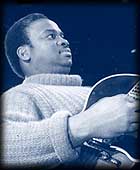
|
|
|
|
|
|
© Jeffrey Kliman |
Russell Malone Virtuoso guitarist Russell Malone brings new meaning to the term versatility, whether he’s playing a down-home, gut-bucket blues or a lush, melodic ballad. Malone’s musical journey began in his church, continued with the study of the blues and country sounds of his native Georgia, and drew insights from some of jazz’s great mentors. A spirited Kennedy Center audience testifies to Malone’s amazing and wide-ranging abilities with thunderous applause, as he opens the show with Thelonious Monk’s "Rhythmining." As a young boy in Albany, GA, Malone was fascinated by the guitar playing at the church service his family attended. His mother observed his fascination and bought him a plastic toy guitar. He recalls learning the D chord first, "I just strummed that chord all day, man. You couldn’t tell me I wasn’t playing." The audience gets involved from the start, as Malone beckons them to clap to the rhythm of an old church song. Russell also recalls the influence of groups like the Dixie Hummingbirds and Sam Cooke with the Soul Stirrers, and cites seeing B.B. King on television as a pivotal moment, "[he] was so close to the way the minister in the church would deliver a sermon." Malone learned much of his technique by listening to records by guitarists like George Benson, Wes Montgomery and Charlie Christian. Despite being largely self-taught, he extols the guidance of his mentors. He recalls spending time with guitarist John Collins, who played with the Nat King Cole Trio and pianist Art Tatum. Collins broadened Malone’s perspective of the guitar. "I was mostly concerned about playing a lot of fast things" and single lines of notes, Malone recalls. Collins demonstrated the harmonic potential of the instrument, and said, "the guitar can function as a small orchestra if you approach it that way." Malone demonstrates how well he learned this lesson with gorgeous renditions of Bill Evans’ "Two Lonely People" and Jerome Kern’s "Yesterdays." Dr. Taylor highlights the lyrical quality of Malone’s playing, which Russell attributes in part to the advice of singer Freddy Cole. Cole recommended that Malone listen closely to singers and horn players to get a stronger sense of how to phrase a melody. Quoting the great saxophonist Lester Young, Dr. Taylor notes that you must "tell your own story" as a soloist. To continually expand upon his own technique, Malone observes guitar great Bucky Pizzarelli as often as he can, just to observe Pizzarelli's inventiveness with the instrument. He also notes the importance of constantly challenging himself. As usual, the audience asks excellent questions of our guest. One member asks Malone to share a pivotal experience that helped him mature as a musician. He recalls playing with the great organist Jimmy Smith at an Atlanta club. Malone was a bit cocky that night and played, in his words, "a whole lot of crowd pleasing nonsense." Then Smith called out a standard and Malone was not even able to follow the tune. He recalls his humiliation, "[it] kicked my little behind from Genesis to Revelations." Smith took him aside later and reminded him that he’d taught a lot of things to Malone’s guitar idols, including Wes Montgomery and Kenny Burrell. He explained that the key is to play with the band and not try to steal the show. In response to another question, Malone explains his preference for using down-strokes as a way to give definition to each note in a chord. He demonstrates his technique on a beautiful composition of his own, titled "Strange Little Smile." At another point, Malone displays his amazing facility with every facet of blues guitar. His "Blues in G" electrifies the bandstand and energizes the audience. Towards the end, Dr. Taylor and his trio chime in, lending a soulful, rhythmic backbone to Malone’s dazzling solo artistry. Other musical highlights include Jerome Kern’s lovely ballad "Nobody Else But Me" and a show-stopping rendition of the Rodgers and Hart number "Lover." Don't miss Russell Malone in our Photo Gallery!
|
|
| |

